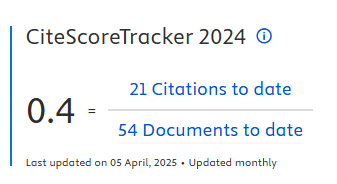The role of social capital in developing sustainable micro-entrepreneurship among rural women in India: a theoretical framework
DOI:
https://doi.org/10.5585/iji.v10i3.21771Keywords:
Micro entrepreneurship, Social capital, Self help group, NGO, Sustainable.Abstract
Objective of the Study: To analyze the role of social capital in developing sustainable micro-entrepreneurship among rural women. In addition, it also interprets the conceptual understanding of social capital, micro-entrepreneurship development, and the determinants that promote micro-entrepreneurship have been discussed.
Relevance/Originality: There are numerous ways to achieve entrepreneurship, but social capital is one way to develop entrepreneurship. Social capital consists of mutual trust, understanding, reciprocity, social relation, collective actions, etc., among its group members.
Methodology/Approach: This article presents a conceptual, theoretical framework by scrutinizing the archive literature to comprehend social capital's role in developing sustainable micro-entrepreneurship. Three forms of social capital, namely Self Help Group, SHG federation, and NGO, have been considered for this study. These social capitals then correlate with each of the indicators of micro-entrepreneurship identified and examined the role of social capital in developing sustainable micro-entrepreneurship among rural women.
Main Results: Three forms of social capital such as SHG, SHG federation, and NGO that have been taken for this study, contributes to sustainable micro-entrepreneurship in various ways, i.e. SHG and SHG federation help in achieving social factors and financial inclusion, whereas NGOs provide entrepreneurial training and suitable business network for the women-owned enterprises.
Theoretical/Methodological contributions: This study contributes to developing a theoretical framework by analyzing the pieces of literature that contribute to sustainable micro-entrepreneurship development through social capital.
Social/management contributions: Social capital promotes sustainable micro-entrepreneurship, which leads to the employment generation, generates regular sources of income, addresses multiple social and economic issues, and promotes a better means of livelihood for rural women.
Downloads
References
Ahmad, M. U. (2016). A Factor Analysis Based Study on Microenterprises. Amity Journal of Entrepreneurship 1(1), (62-70). https://amity.edu/UserFiles/admaa/222Paper%204.pdf
Ahmad, N., and Hoffman, A. (2017). A Framework for Addressing and Measuring Entrepreneurship. Entrepreneurship Indicators Steering Group. OECD Paris. https://www.oecd.org/sdd/business-stats/39629644.pdf
Ajani, E. N., and Igbokwe, E. M. (2014). Constraints to Livelihood Diversification among Rural Women in Anambra State, Nigeria. Journal of Agricultural Extension. Vol.18 (2). https://doi.org/10.4314/jae.v18i2.4
Anderson, A., Park, J., & Jack, S. (2007). Entrepreneurial Social Capital: Conceptualizing Social Capital in New High-tech Firms. International Small Business Journal, 25(3), 245–272. https://doi.org/10.1177/0266242607076526
Annual Report (2021). Ministry of Micro, Small and Medium Enterprises, Govt of India. https://msme.gov.in/sites/default/files/MSME-ANNUAL-REPORT-ENGLISH%202020-21.pdf
Bhattacharya, S., & Londhe, B. R. (2014). Micro Entrepreneurship: Sources of Finance & Related Constraints. Procedia Economics and Finance, 11, 775–783. https://doi.org/10.1016/s2212-5671(14)00241-x
Carroll, T. F. (2001). Social capital, local capacity building, and poverty reduction (No. 3). Asian Development Bank. https://www.adb.org/sites/default/files/publication/30322/social-capital-socdevpaper3.pdf
Cattell, V. (2001). Poor people, poor places, and poor health: the mediating role of social networks and social capital. Social science & medicine, 52(10), 1501-1516. https://doi.org/10.1016/s0277-9536(00)00259-8
Chatterjee, S., Gupta, S., D., & Upadhyay, P. (2018). Empowering women and stimulating development at bottom of pyramid through micro-entrepreneurship. Management Decision, 56(1), 160–174. https://doi.org/10.1108/md-04-2017-0296
Cho, Y., Robalino, D., & Watson, S. (2016). Supporting self-employment and small-scale entrepreneurship: potential programs to improve livelihoods for vulnerable workers. IZA Journal of Labor Policy, 5(1). https://doi.org/10.1186/s40173-016-0060-2
Claridge, T. (2018). Explanation of the different levels of social capital: individual or collective. Social Capital Research, Institute for Social Capital. https://www.socialcapitalresearch.com/levels-of-social-capital/
Claridge, T. (2018). Functions of social capital–bonding, bridging, linking. Social capital research, 20, 1-7. https://www.socialcapitalresearch.com/wp-content/uploads/2018/11/Functions-of-Social-Capital.pdf
Coleman, James S. (1988). Social Capital in the Creation of Human Capital. American Journal of Sociology, 94(), S95–S120. https://doi.org/10.1086/228943
Coleman, S. (2000). Access to Capital and Terms of Credit: A Comparison of Men and Women-Owned Small Businesses. Journal of Small Business Management, 38, 37-52. https://www.researchgate.net/publication/280017695_Access_to_capital_and_terms_of_credit_A_comparison_of_men-_and_women-owned_small_businesses
Dey, S. (2018). The Role of Employment Diversification in Reducing Vulnerability to Poverty among Marginal and Small-holder Agricultural Households in India. Margin-The Journal of Applied Economic Research. 12: 1, 88–112. https://doi.org/10.1177/0973801017740661
Dhar, S. N., & Sarkar, S. (2013). Ensuring Sustainability of Self-Help Groups through Effective Marketing Strategies: An Empirical Study. International Journal of Marketing & Business Communication, 2(1), 39.
Dhiman, P. K & Rani, A. (2014). A study on marketing strategies of self-help groups in Punjab: challenges and constraints. International Journal of Sales & Marketing Management Research and Development (IJSMMRD) ISSN (P): 2249-6939; ISSN (E): 2249-8044 Vol. 4, Issue 3, Jun 2014, 1-10. http://www.tjprc.org/publishpapers/2-33-1399387360-Sales_-_IJSMMRD_-_A_STUDY_ON_MARKETING_STRATEGIES_-_Amita_Rani.pdf
Fornoni, M., Arribas, I., & Vila, J. E. (2012). An entrepreneur’s social capital and performance: The role of access to information in the Argentinean case. Discussion Papers on Economic Behaviour. The Estructura de Recerca Interdisciplinar Comportament Economic - Social (ERI-CES). https://ideas.repec.org/p/dbe/wpaper/0712.html
Gandhi, K., & Udayakumari, N. (2013). Marketing Strategies of Women Self Help Groups. International Journal of Current Research and Academic Review, 1(2), 117-122. https://doi.org/10.26703/JCT.v15i2-5
Geetha, N. (2014). Rural Women empowerment through micro-entrepreneurship development: Issues and prospects-A Review. IOSR J. of Econ. and Fin., 3(2), 18-20.
Gherhes, C., Williams, N., Vorley, T., & Vasconcelos, A. C. (2016). Distinguishing micro-businesses from SMEs: A systematic review of growth constraints. Journal of Small Business and Enterprise Development. https://doi.org/10.1108/JSBED-05-2016-0075
Gichuki, C. N., Mulu-Mutuku, M., & Kinuthia, L. N. (2014). Performance of women owned enterprises accessing credit from village credit and savings associations in Kenya. Journal of Global Entrepreneurship Research, 4(1). https://doi.org/10.1186/s40497-014-0016-1
Granovetter, M. S (1973). The Strength of Weak Ties. American Journal of Sociology, Vol. 78, No. 6, pp. 1360-1380. https://snap.stanford.edu/class/cs224w-readings/granovetter73weakties.pdf
Grootaert, C., & van Bastelaer, T. (2001). Understanding and Measuring Social Capital: A Synthesis of Findings and Recommendations From the Social Capital Initiative. Social Capital Initiative, Working Paper No. 24, World Bank. https://www.casede.org/CapitalSocial/World_Bank_Understanding_social%20capital.pdf
Hazarika, B., & Goswami, K. (2018). Micro-entrepreneurship development in the handloom industry: an empirical analysis among the tribal women in Assam. International Journal of Rural Management, 14(1), 22-38. https://doi.org/10.1177/0973005218754437
Higgins, A., C. (1961). SOCIAL BEHAVIOR: ITS ELEMENTARY FORMS. By George Caspar Homans. New York: Harcourt, Brace and World, Inc., 1961. 404 pp. $5.50, Social Forces, Volume 40, Issue 2, December 1961, Pages 180–181, https://doi.org/10.2307/2574301c
Jamilmiya, K. K. (2018). Role of NGOs in Rural Entrepreneurship. International Journal of Scientific Engineering and Technology, 7(7), 59-61. https://www.ijset.com/publication/v7/013.pdf
Jayachandran S. (2021) Microentrepreneurship in Developing Countries. In: Zimmermann K.F. (eds) Handbook of Labor, Human Resources and Population Economics. Springer, Cham. https://doi.org/10.1007/978-3-319-57365-6_174-1
Jothilakshmi, M., Krishnaraj, R., & Sudeepkumar, N. K. (2009). Empowering the Members of Women SHGs in Livestock Farming through Need-Based Trainings. Asia-Pacific Journal of Rural Development, 19(2), 17–30. https://doi.org/10.1177/1018529120090202
Justo, R., Castro, J. O. D., & Olivares, A. M. (2008). Indicators of entrepreneurship activity: some methodological contributions. International Journal of Entrepreneurship and Small Business, 6(4), 604. https://doi.org/10.1504/ijesb.2008.019504
Kirve, H., & Kanitkar, A. (1993). Entrepreneurship at the Grass- roots: Developing the Income- generating Capabilities of Rural Women. The Journal of Entrepreneurship, 2(2), 177–197. https://doi.org/10.1177/097135579300200203
Lenka, U., & Agarwal, S. (2017). Role of women entrepreneurs and NGOs in promoting entrepreneurship: case studies from Uttarakhand, India. Journal of Asia Business Studies, 11(4), 451–465. https://doi.org/10.1108/jabs-07-2015-0088
Lunati, M., Zu Schlochtern, J. M., & Sargsyan, G. (2010). Measuring Entrepreneurship The OECD-Eurostat Entrepreneurship Indicators Programme. OCED Statistic Brief. OECD Paris. https://www.oecd.org/sdd/business-stats/39629644.pdf
Mathur, P., & Agarwal, P. (2017). Self-help groups: a seed for intrinsic empowerment of Indian rural women", Equality, Diversity and Inclusion: An International Journal, Vol. 36 Issue: 2, pp.182-196. http://dx.doi.org/10.1108/EDI-05-2016-0039
Meera, S., & Vinodan, A. (2019). Exploring the Potential for Rural Entrepreneurship through Integrated Community-based Intervention Strategies. Vision: The Journal of Business Perspective, 23(1), 70–79. https://doi.org/10.1177/0972262918822165
Meressa, H. A. (2020). Growth of micro and small scale enterprises and its driving factors: empirical evidence from entrepreneurs in emerging region of Ethiopia. Journal of Innovation and Entrepreneurship, 9(1), 1-22. https://doi.org/10.1186/s13731-020-00121-9
Mohapatra, S., & Sahoo, B. K. (2016). Determinants of participation in Self Help Groups (SHG) and its impact on women empowerment. Indian Growth and Development Review, 9(1), 53–78. https://doi.org/10.1108/igdr-04-2015-0016
Mahato, J., & Jha, M. K. (2021). Social Capital and Micro Enterprise Development towards Occupational Diversification in Rural Context. In S.M. Akhtar (Ed.), Architecture & Planning for Villages (pp. 344-348). Published by Wellworth Books International (ISBN No. 978-81-953960-0-9). Available at https://www.researchgate.net/publication/356108444_Architecture_Planning_for_Villages
NRLM (2016). Model Community Operational Manual (COM). National Rural Livelihood Mission, Government of India. https://aajeevika.gov.in/sites/default/files/nrlp_repository/COM.pdf
NRLM (2018). An Introduction to Best Performing Village Organizations under DAY-NRLM, National Rural Livelihood Mission, Government of India. https://aajeevika.gov.in/en/content/introduction-best-performing-village-organizations-under-day-nrlm
Onyx, J., & Bullen, P. (2000). Measuring social capital in five communities. The journal of applied behavioral science, 36(1), 23-42. https://doi.org/10.1177/0021886300361002
Osei, C. D., & Zhuang, J. (2020). Rural Poverty Alleviation Strategies and Social Capital Link: The Mediation Role of Women Entrepreneurship and Social Innovation. SAGE Open, 10(2), 215824402092550. https://doi.org/10.1177/2158244020925504
Portes, A. (2014). The downside of social capital. Proceedings of the National Academy of Sciences, 111 (52). https://doi.org/.1073/pnas.1421888112
Preethi, K. A. (2017). Role of NGOs in Women Entrepreneurship Development: A Grass-Root Level Experience, Amity Journal of Entrepreneurship 1(2), (44-58). https://amity.edu/UserFiles/admaa/32710055%20Paper%204.pdf
Purushotam, P (2009). Marketing support to the SHGs. In Verma S B & Pawar Y T (eds.) Rural Empowerment through Self Help Groups (SHGs), Non-Government Organizations (NGOs) and Panchayat Raj Institutions (PRIs) (pp.3-14), New Delhi: Deep & Deep Publications Pvt. Ltd.
Putnam, R. D. (1993). What makes democracy work? 82(2), 101–107. https://doi.org/10.1002/ncr.4100820204
Putnam, R., Leonardi, R., & Nanetti, R. (1993). Making democracy work Princeton. NJ: Princeton University Press. https://press.princeton.edu/books/paperback/9780691037387/making-democracy-work
Roxas, H. B., & Azmat, F. (2014). Community social capital and entrepreneurship: Analyzing the links. Community Development, 45(2), 135-150. http://dx.doi.org/10.1080/15575330.2014.880495
Saha, B., & Bahal, R. (2014). Factors Leading to Success in Diversified Occupation: A Livelihood Analysis in India. The Journal of Agricultural Education and Extension. https://doi.org/10.1080/1389224X.2014.927372
Sahai, S., Ray, R. S., & Tapasvi, S. K. (2020). Determinants of growth for the informal sector micro-enterprises: an empirical study in India. Enterprise Development & Microfinance, 31(2), 76-91. https://doi.org/10.3362/1755-1986.19-00005
Sharma, P. (2013). Women entrepreneurship development in India. Global Journal of Management and Business Studies, 3(4), 371-376. http://ripublication.com/gjmbs_spl/gjmbsv3n4_05.pdf
Singh, V. K. (2015). The Role of NGOs in Promoting Women Entrepreneurship. Indian Journal of Society and Politics, 2(2), 25-28. https://amity.edu/UserFiles/admaa/32710055%20Paper%204.pdf
Sucharita, S. & Bishnoi, I. (2019). A study on marketing strategy of the SHGs in Ranapur block of Odisha. Indian Journal of Social Research. Vol. 60 (3). http://academic-and-law-serials.com/images/pdf/Article9-ISR-60(3).pdf
Suprabha, K. R. (2014). Empowerment of Self Help Groups (SHGs) towards Microenterprise Development. Procedia Economics and Finance, 11, 410–422. https://doi.org/10.1016/s2212-5671(14)00208-1
Swain, R. B., & Varghese, A. (2011). Delivery Mechanisms and Impact Of Microfinance Training In Indian Self-Help Groups. Journal of International Development, 25(1), 11–21. https://doi.org/10.1002/jid.1817
UNDP (2019). Certificate Course Curriculum and Training Manuals for Biz-Sakhi: Community-based mentors for Women Entrepreneurship promotion and Empowerment. UNDP India, New Delhi. https://www.in.undp.org/content/india/en/home/library/poverty/Biz_Sakhi_curriculum.html
Woolcock, M. (1998). Social Capital and Economic Development: Toward a Theoretical Synthesis and Policy Framework. Theory and Society, 27(2), 151–208. https://doi.org/10.2307/657866
Woolcock, M. (2001). The Place of Social Capital in Understanding Social and Economic Outcomes. ISUMA Canadian Journal of Policy Research 2 (1):11-17. https://www.oecd.org/education/innovation-education/1824913.pdf
World Bank (2019). Economic Diversification: Lessons from Practice, Aid for Trade at Glance 2019: Economic Diversification and Empowerment. World Bank Group. https://www.wto.org/english/res_e/booksp_e/aid4trade19_chap5_e.pdf
Downloads
Published
How to Cite
Issue
Section
License
Copyright (c) 2022 Jogeswar Mahato, Manish Kumar Jha, Saurabh Verma

This work is licensed under a Creative Commons Attribution-NonCommercial-ShareAlike 4.0 International License.
- Abstract 838
- PDF 678











